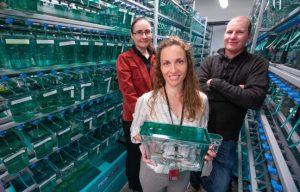ISU researcher ‘blown away’ by blood cell replication discovery
September 13th, 2024 by Ric Hanson
(Radio Iowa) – A group of Iowa State University researchers has made a discovery that could lead to a new treatment for patients with blood disorders like leukemia. Clyde Campbell, a professor of genetics, development and cell biology at Iowa State, is on the research team. “I think we are definitely on the verge of making a huge advancement in the use of cell transplants to help cure blood cancers,” Campbell said during a Radio Iowa interview.
Blood cancers account for about 10% of all diagnosed cancers in adults each year and about 25% of all cancers in children. Treatment is often a transplant of bone marrow from a live donor, to respond to the way cancer disrupts the body’s production of blood stem cells. Campbell is the ISU researcher who first observed the switch inside a zebrafish stem cell that triggered production of blood stem cells. “There are very few moments in a scientist’s life where you see something that just kind of blows you away,” Campbell said.

Iowa State University researchers Raquel Espin Palazon (center), Karin Dorman and Clyde Campbell in ISU’s Advanced Teaching and Research Building. (Photo by Christopher Gannon/Iowa State University)
What Campbell saw through his microscope was a 100-fold increase in the number of blood stem cells produced after a certain protein was added. “It really almost knocked me out of my seat,” Campbell said, “because what we were able to produce has never been observed.”
Campbell explains scientists were already able to take non-vital cells from a patient’s skin, add a mixture of key components in a laboratory dish and produce stem cells. “Now where we’re at is trying to drive those cells to become specifically blood stem cells,” Campbell told Radio Iowa. “That way we’d have the ability to introduce the patient’s own cells into their body.”
That would eliminate the need for a bone marrow transplant, as well as the powerful prescription drugs patients have to take long after the transplant. The I-S-U research has been published in Nature Communications, a scientific journal.
It will “definitely take some time” to develop and ensure the process of producing blood stem cells in a lab and putting them back in the patient’s body is safe, according to Campbell. Campbell and others on the ISU research team are working with the Children’s Hospital of Philadelphia to do more testing on the production of blood stem cells in a lab. Part of a $2 million federal grant is being used to build a new lab on the Ames campus to continue the research team’s work.





